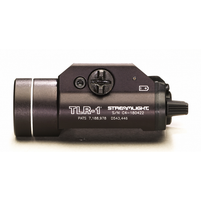Streamlight TLR Series: A Comprehensive Comparison
The Streamlight TLR series is known for its reliability, performance, and affordability, making it a popular choice for law enforcement, military, and civilian use. With so many models available, you may wonder how they differ from one another. In this post, we’ll answer some of the most common questions about the TLR-1, TLR-2, TLR-7A, TLR-7X, TLR-8A, and more, while also covering important details like battery life, compatibility, and durability.
1. What Is the Difference Between the TLR-1 and TLR-2?
The TLR-1 and TLR-2 are two of the most popular models in the TLR series, but they differ in one key way:
- TLR-1:
- This model is a tactical weapon light that delivers up to 1,000 lumens of bright white light. It’s designed for maximum visibility in low-light situations, providing a focused beam for target identification.
- No laser: The TLR-1 is strictly a flashlight without any laser sight.
- Battery life: Powered by two CR123A lithium batteries, it offers about 1.5 hours of runtime.
- Compatibility: Fits most full-size and compact firearms with Picatinny or Glock-style rails.
- TLR-2:
- The TLR-2 also delivers 1,000 lumens of light but includes an integrated laser sight, available in either red or green. The laser helps improve target acquisition, particularly in close-quarter situations or when precision is key.
- Laser option: The inclusion of the laser makes the TLR-2 more versatile for those who need both a light and laser in one device.
- Battery life: Also powered by two CR123A lithium batteries with a similar runtime of 1.5 hours.
Summary: The main difference is the laser. The TLR-1 is a standard light, while the TLR-2 combines a tactical light with a laser for more advanced targeting.
2. Is the TLR-7A the Same as the TLR-7X?
No, the TLR-7A and TLR-7X are not the same, although they share some similarities.
- TLR-7A:
- This model offers 500 lumens of output and is designed for compact firearms. It features ambidextrous controls and offers the choice between a high or low switch for activation. The TLR-7A is popular for concealed carry due to its small size and ease of use.
- Battery life: Powered by one CR123A battery, it offers around 1.5 hours of runtime.
- Compatibility: Ideal for compact handguns, it fits Picatinny or Glock-style rails.
- TLR-7X:
- The TLR-7X has similar specs to the TLR-7A but adds a strobe function. The strobe can be activated for disorienting threats in a tactical situation. Other than this feature, the TLR-7X is quite similar to the TLR-7A in terms of size and output.
Summary: The TLR-7X adds a strobe feature to the basic design of the TLR-7A, making it more versatile for tactical situations.
3. What Is the Difference Between the TLR-8A G and TLR-8G?
The TLR-8A G and TLR-8G are both combination light and laser models, but their design and controls set them apart:
- TLR-8A G:
- This model features 500 lumens of light output and an integrated green laser. The main difference here is the switch design. The TLR-8A G uses an ambidextrous high or low switch system, which allows the user to choose the switch position for easier activation.
- Battery life: Powered by one CR123A battery, offering about 1.5 hours of continuous runtime.
- TLR-8G:
- The TLR-8G offers similar performance (500 lumens with a green laser) but lacks the high or low switch option found in the TLR-8A G. Instead, it uses the standard ambidextrous switch without customization for switch height.
Summary: The key difference is in the switch design. The TLR-8A G offers a high/low switch option, while the TLR-8G has a standard ambidextrous switch.
Additional Considerations for the Streamlight TLR Series:
Battery Life and Power Source
Streamlight TLR lights are known for their efficient power usage. Here’s a summary of the battery life and power source for the main models:
- TLR-1 and TLR-2: Both are powered by two CR123A lithium batteries and provide 1.5 hours of runtime.
- TLR-7A, TLR-7X, TLR-8A G, and TLR-8G: These models are powered by one CR123A battery, with a similar runtime of about 1.5 hours.
Durability and Weather Resistance
All Streamlight TLR models are built to withstand tough conditions, making them reliable choices for tactical and outdoor use. Key durability features include:
- Waterproof rating: Most models are IPX7 waterproof (submersible up to 1 meter for 30 minutes).
- Impact resistance: Rated for 2 meters, ensuring durability in challenging environments.
Mounting and Compatibility
Streamlight TLR lights are designed for easy attachment to firearms. Their quick-detach rail clamp system allows for easy installation without tools. They fit most Picatinny or Glock-style rails and are compatible with many popular handguns like Glock, Sig Sauer, Smith & Wesson, and more.
Price Point Considerations
Pricing varies based on the model and its features:
- TLR-1 and TLR-2 are generally more expensive due to their higher lumen output and, in the case of the TLR-2, the added laser feature.
- TLR-7A and TLR-7X are more affordable options, ideal for compact firearms and concealed carry.
- TLR-8A G and TLR-8G combine tactical lights with lasers, which typically makes them more expensive than light-only models.
Conclusion
The Streamlight TLR series offers a wide range of tactical lights and light-laser combos to fit various needs, whether you're looking for a high-output light like the TLR-1, a compact option like the TLR-7A, or a versatile light/laser combo like the TLR-8A G. Understanding the differences between models helps you choose the right one for your firearm and tactical needs.
Whether you're outfitting a full-sized firearm or a compact handgun, the Streamlight TLR series has a model that delivers reliable performance, from the 500-lumen compact lights to the powerful 1,000-lumen TLR-1.

